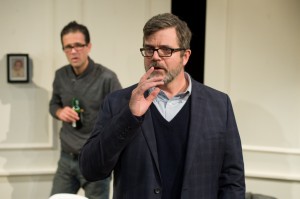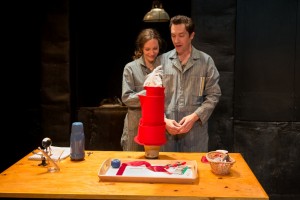Fear is the watchword for The Gamm’s 29th Season opener with a unique double-bill that pairs two masterful works from the celebrated Caryl Churchill. A Number and Far Away share many qualities, but for all of their near-futuristic, science-fiction horror and vague portents of forthcoming dystopian muck, the chief fear emanating from the audience was not about the plays’ parallels to our current global crises and scientific overreach. The urgent whispering in the aisles and back rows and lobby was not concerning these stark and darkly humorous glimpses into our own isolated souls. The fear was solid and definable – most everyone (at least on the night we attended) was scared to admit that they didn’t understand a single thing that was happening, although they loved every second.
As more admitted their confusion, the tension eased. We’re permitted a certain level of bafflement with Churchill (and Far Away, in particular). Critical essays abound on both of these pieces and the playbill alone is riddled with Director’s Notes and further attempts to contextualize the plays, but it all serves no better than trying to explain a dream. A Number seems straightforward enough, until you actually start to explain it out loud – a father’s life unravels as he discovers that his seemingly innocent desire to prolong the existence of his beloved baby boy through cutting-edge cloning methods has gone awry. The father finds that, in actuality, several clones exist and now the chickens are coming home to roost. It’s a modern take on a grown child’s discovery that he’s adopted and of a parent confronting abandoned offspring years later. Nature vs. Nurture, Herd Mentality vs. Individualism and many other heady questions abound, but there’s a rotten underbelly here and Churchill deftly allows us to only glimpse rather than understand the motivations of Salter, the father, and of each of his offspring, both real and manufactured. Far Away is something else entirely, like watching Love Letters superimposed on top of Brazil and the nightly news, all running at different speeds and in opposite directions. Yes, it’s about Fear writ large, but the epic scenario of a world truly at war with itself barely covers the surface. In the end, we know we’re scared, we know that our world has become a gutter of form over substance and we know that if we don’t find someone or something to love, even standing up for your beliefs won’t matter if those beliefs are wrong. As Alex Platt’s character, Todd, notes, “No one believes they’re the bad guy.” The big Fear may very well be that we’ll find out one day that we’re on the wrong side of it all.
However, none of this is meant to indicate anything other than that The Gamm has produced another winner, albeit one that will continue to chew away at you for a while. It’s also important to note just how funny each of these plays are and Directors Judith Swift and Tony Estrella have maximized the absurdity and comic potential of each these works.
 Sound designer Charles Cofone works overtime here with a montage of children’s voices singing and cooing, but with a ghostly quality that promises something unsettling as A Number approaches. Cinematic soundscapes accompany the cleverly staged scene changes with rhythmic, mechanical repetition implying the cookie cutter approach toward the clones that make up Salter’s brood. As Salter, Jim O’Brien delivers the steady slow burn with bursts of temper that are his signature and Tony Estrella makes nice work of portraying three different sons/clones with just enough similarity to keep this from becoming a clever acting exercise. Churchill’s difficult, overlapping language and repeating patterns mimic how we actually speak, but it does take a while for those rhythms to become natural to the pair. Even with the original British idioms kept intact, however, Estrella and O’Brien make the dialogue sing by the time we reach the unsettling conclusion that identity is not a rubber stamp and when we search for ourselves in others, we may not like what we find.
Sound designer Charles Cofone works overtime here with a montage of children’s voices singing and cooing, but with a ghostly quality that promises something unsettling as A Number approaches. Cinematic soundscapes accompany the cleverly staged scene changes with rhythmic, mechanical repetition implying the cookie cutter approach toward the clones that make up Salter’s brood. As Salter, Jim O’Brien delivers the steady slow burn with bursts of temper that are his signature and Tony Estrella makes nice work of portraying three different sons/clones with just enough similarity to keep this from becoming a clever acting exercise. Churchill’s difficult, overlapping language and repeating patterns mimic how we actually speak, but it does take a while for those rhythms to become natural to the pair. Even with the original British idioms kept intact, however, Estrella and O’Brien make the dialogue sing by the time we reach the unsettling conclusion that identity is not a rubber stamp and when we search for ourselves in others, we may not like what we find.
 Far Away presents new opportunities for Cofone and scenic designer Michael McGarty to shine, and lighting designer Jen Rock ties it together beautifully. Far Away moves from a rustic cabin to a factory to a Nuremburg fashion show from Hell and back again. The much loved projections that are utilized in most Gamm productions aid in identifying our sense of space, but the multipurpose flats and platforms that are skillfully twisted and moved throughout are stars in their own right. On this multifaceted stage, we are treated to one of the best performances that Gamm resident Casey Seymour Kim has delivered in quite some time (which is saying something).
Far Away presents new opportunities for Cofone and scenic designer Michael McGarty to shine, and lighting designer Jen Rock ties it together beautifully. Far Away moves from a rustic cabin to a factory to a Nuremburg fashion show from Hell and back again. The much loved projections that are utilized in most Gamm productions aid in identifying our sense of space, but the multipurpose flats and platforms that are skillfully twisted and moved throughout are stars in their own right. On this multifaceted stage, we are treated to one of the best performances that Gamm resident Casey Seymour Kim has delivered in quite some time (which is saying something).
Far Away starts with a disturbing and nebulous backstory, punctuated with scratchy Woody Guthrie odes to Liberty as Kim’s Auntie Harper tries to soothe the very real fears of her niece, Joan. Joan has witnessed atrocities in the backyard that no adult should ever see, let alone a child, and just as we start to think we’ll get some explanation as to what this could all mean, we’re thrust forward in time to where Joan has matured and found a place in whatever stands for society in this time period. We’re witness to the twisted, yet sweet love story between Todd (a measured and clinically wonderful Alex Platt) and Joan ( exceptionally delivered by Marianna Bassham) as they navigate their way through the bizarre world of prisoners, expanding war and workplace nepotism and they exhibit an onstage chemistry that seems years in the making. As highly skilled milliners in a gloomy, militaristic factory, their love story develops as they make ridiculously fancy hats for condemned prisoners, all in the hopes that perhaps one of their creations may be immortalized. When we are finally exposed to the horror of what it’s like to see this parade of jumpsuits in Technicolor fascinators marching toward a gruesome death, it is one of those moments in theater that one can never forget. Amanda Downing Carney’s costumes and David Howard’s millinery combine with powerful lighting and exquisite sound choices to form a spine-tingling picture, like a deathly retelling of Go Dog Go on acid. Any sense of timeline we thought we had is shot and what could have been Nazi Germany could be 1984 could be today could be tomorrow. We end Far Away where it starts, in a cabin, relatively isolated, but with the idea of war and death all around. As the absurdity becomes commonplace and the metaphors start to swallow their own tails, our fear grows. We’re afraid because we don’t understand any of it, but we’re more afraid because maybe, just maybe, we actually do.



